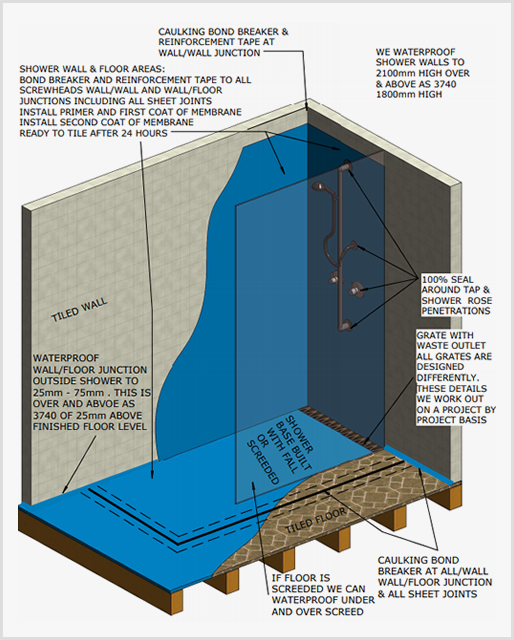Facts About Waterproofing Auckland Revealed
Table of ContentsFacts About Waterproofing Auckland UncoveredWhat Does Waterproofing Auckland Mean?Not known Factual Statements About Waterproofing Auckland Waterproofing Auckland for DummiesRumored Buzz on Waterproofing AucklandThe Of Waterproofing Auckland
Waterproofing structures is the approach of creating a barrier over surfaces of structures, roofs, wall surfaces and various other structural members of structures to avoid water infiltrations through these surfaces. In summary, building surfaces are made water-resistant and also waterproof. Research has actually shown that waterproofing only represents 1% of a structure's building and construction costs yet when ignored, it can be responsible for almost 90% of the damages.
You need to make certain that you get the best kinds of waterproofing products for your unique demands. To aid you in the choice process, listed below are the 5 types of waterproofing in construction: Cementitious waterproofing items are thought about as the easiest waterproofing materials to utilize. These are readily available from vendors of masonry items like, as well as they're very easy to mix and use.
Polyurethane fluid membrane layer technique of waterproofing is usually utilized for the level roofing system location as well as revealed to weathering. This type of waterproofing product is extremely sensitive to moisture web content present. Before application, it is essential to be extra careful in examining the dampness web content of the concrete slab, otherwise peeling or de-bonding of membrane layers might take place after some time.
It supplies more flexibility than the cementitious kinds of waterproofing. At the end of the day, there are many distinct types of waterproofing materials in the market.
All about Waterproofing Auckland
Just how does basement waterproofing work? Interior basement waterproofing functions by attending to water seepage where it manifests itself inside.

Exterior basement waterproofing strategies minimize this stress by redirecting water into a gravel-covered ground drainpipe, which lugs it far from your house. While both techniques of basement waterproofing job well, they deal with the trouble in different ways. Interior basement waterproofing stays a prominent option due to its relatively affordable price point, while exterior basement waterproofing works for home owners that favor to stay clear of indoor building and construction job.
Get in touch with us today for more information about the basement waterproofing work we conduct for Georgia property owners.
The Ultimate Guide To Waterproofing Auckland
It is necessary to water-proof your home. Interior areas of our house have to be maintained completely dry from roofing system to basement. Waterproofing your house before building and construction will avoid these troubles. If you water-proof your house, it will certainly avoid damages later on. gale seepage. Such problems will certainly call for a specialist and also some basic knowledge concerning the issue as well as options to it.
It is likewise crucial for the honesty of the structure. Depending on the level of water damage or proprietor preference, waterproofing systems can be installed inside your home or outdoors.
The poly acrylic chemical option is prepared which is utilized to secure the breakage or leak on the wall and balcony which will be a strong water resistant base as well as safeguard and also protect the toughness of any structure. This is done by an extremely trained professional group. You need to make sure that high-quality products are visit this site right here utilized for the treatment.
The last step is to put 2 layers of poly acrylic chemical with white cement externally. is ideal for structures and also frameworks that are currently having leakage or damage in addition to for brand-new structures to avoid leak in future. This procedure aids in keeping the life as well as top quality of the building as well as guarantees that there is no damages to the building due to the rains.
Rumored Buzz on Waterproofing Auckland

Apply a thick cement slurry concrete the surface of the slab. Over this coat, use a finishing layer with concrete sand mortar 1:4 and water-proofing substance as Look At This per the design.
Include color pigments such as red, eco-friendly, etc as per the demand for an eye-catching coating. Make an edge between the parapet and also the sloping slab on the second day. Treat this waterproofing for fifteen days, with wet gunny bags spread out over it. Constant watering is called for on a sloping slab.
See This Report on Waterproofing Auckland
Also, examine the density of the Shahbad floor tiles. It must be in between 32mm to 40mm (1 1/4 to 1 1/2). Preserve the break joint pattern while dealing with the Shahabad floor tiles for the base. After dealing with the Shahabad floor tiles, grout the joints with concrete slurry entirely. Seal the joints in between the Shahabad ceramic tiles with the assistance of C.M.
For the basement, the arrangement of gutter and sump is made in P.C.C. itself and Shahabad base is also prepared in the same style. The seamless gutter is offered an appropriate slope towards the sump. This provision is a safety net versus the periodic entrance of rainwater in the cellar. Over the plastered Shahabad base, plethora slab is cast and the R.C.C.
Rough Shahbad tiles are after that dealt with useful site to the upright pardi from the outside. Apply cool concrete paste on the 4 corners and also in the center of the 25mm (1) Shahabad floor tile, Press this ceramic tile firmly over the R.C.C. pardi in line and also degree. At one time, solution only an elevation of 1.
The Main Principles Of Waterproofing Auckland
loaded with concrete slurry and also say goodbye to slurry is taken in. Heal it for at the very least seven days, a minimum of 10 times a day. After healing, offer the last jointless water-proof plaster coat in C.M. 1:4 over the rough Shahabad. The whole procedure pointed out above types a box around the structure and also does not enable any kind of water to leak via or leak from the cellar.